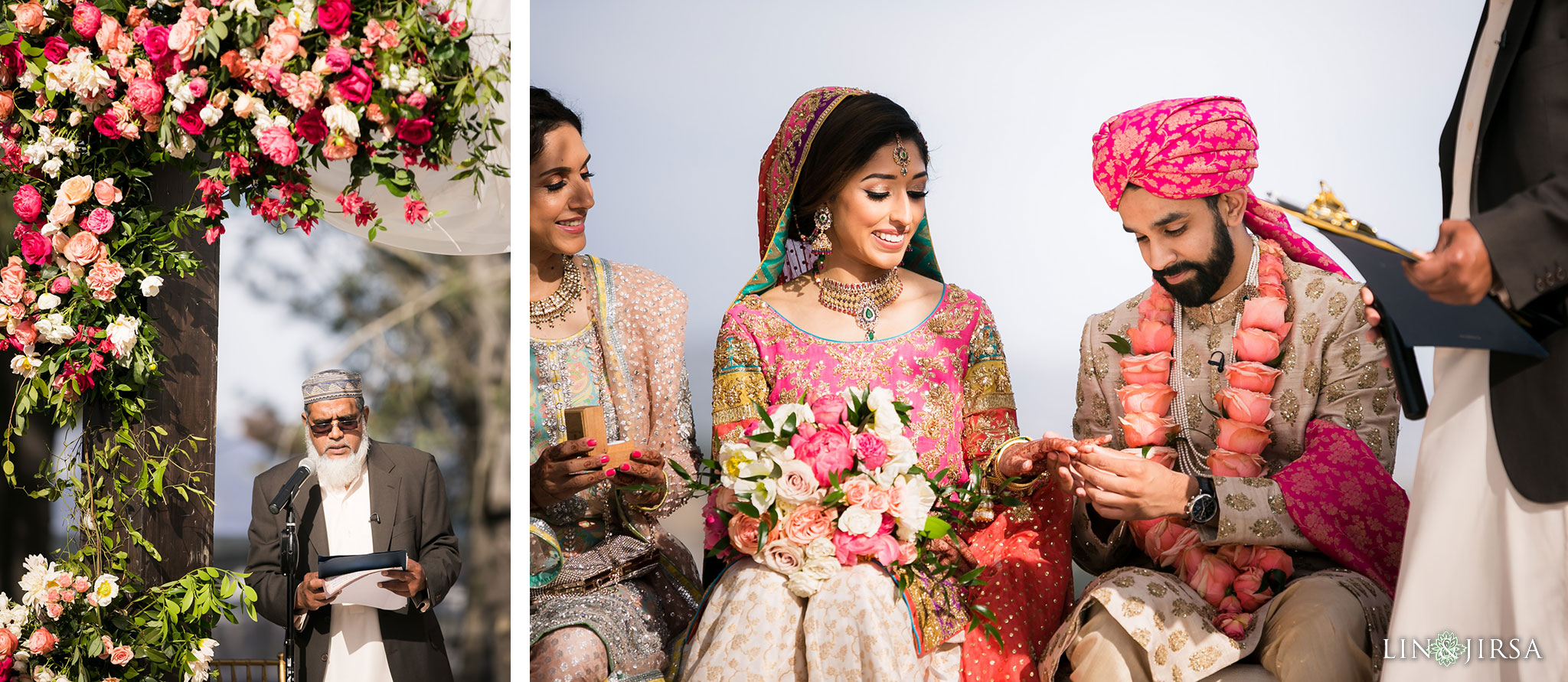
Pre-wedding Rituals
Salatul Ishtikara – Arranged marriages are prevalent among Indian Muslims and the matches are generally sought within the same religious sect and communities. Once a match have been finalized by the families who deem each other compatible, the religious head or the Imam of the nearby mosque is intimated and he performs a special prayer where he seeks Allah’s consent for the intended union and asks Him to bless the future couple. This marks the official announcement of the marriage to the community. The would-be bride and groom also attend the prayers and ask for guidance to Allah through prayer.
Imam Zamin – Following the Ishtikara, the groom’s mother, on an auspicious day, visits the bride’s home carrying gifts and sweets. She also carries a gold or silver coin wrapped inside a silk scarf which she ties around her future daughter-in-law’s wrists. This ritual signifies the formal acceptance of the bride into her future family.
Mangni – Mangni marks the official engagement ceremony between the bride and groom and their respective families. Close friends and relatives from both the families gather on a pre-determined day to witness the bride and groom exchange rings. Each family showers the other with gifts of sweets, fruits, dry fruits, clothes and sometimes cash. This ceremony officially seals the intention of marriage between the two families and the bride and the groom are considered betrothed to each other in the eyes of the society.
Manjha – This is certainly an adopted ritual within the Muslim wedding practices in India. A day or two before the actual Nikah ceremony, the bride is dressed up in yellow finery. A paste made of Turmeric, sandalwood and rose-water is applied to the bride’s face, hands and feet. The women of the family gather for the occasion to participate in a fun and full of mischief event. They take their turn in applying the paste to the bride and to each other. After application of turmeric paste is complete, the bride goes on to take the bath. After her Manjha, the bride is not supposed to leave the house till her wedding day. The same event is also observed at the groom’s house as well.
Mehendi – Middle-eastern and Indo-Pakistani Muslim brides observe an elaborate ritual involving henna paste known as Mehendi. It is again a women-centric event, where the women of the family gather around the bride the evening before the wedding. The most artistic lady in the family is entrusted with the task of applying henna paste in unique, elaborate designs on the bride’s hands and feet. Nowadays, professional mehendi artists are also hired to do the job. It is customary to include the groom’s initials within the bride’s henna designs which he has to discern on their first night together. Other female members of the family also get their hands painted with henna.
Sanchaq – During this pre-wedding ritual, members of the groom’s family visit the bride’s place bearing gifts for her from her future in-laws. Along with these gifts of sweets, fruits etc., the bridal outfit to be worn at the time of the Nikah are also sent. Accompanying the outfit, matching jewelry and other accessories are also sent. Some families even send over perfumes, cosmetics and toiletries for the bride.
Wedding Attires
Generally, Muslim grooms wear Kurta Pajama or Kurta with churidaar. There is generally no color restriction except for black, which is considered the color of mourning among Muslims. Generally some form of embroidery work is preferred on the kurtas to have that Wedding kind of feel. Nowadays, Muslim grooms are more and more drawn towards wearing a Sherwani or some other form of Indo-Western Attires combined with churidaar pajama. The Sherwanis are generally intricately embroidered and smartly cut. The groom wears certain pieces of jewelry with his attire like neck chains in gold, finger rings and may be men’s bracelets. He sometimes may also wear formals like a suit or tuxedo with formal shoes. With Sherwani or kurtas the groom generally wears sandals or Nagrai shoes.
The wedding attire for Muslim bride is pretty strictly outlined in the Holy Quran. At any point, only her face and hands are to be remaining visible to the public and she has to be decently covered up. Salwar Kameez is hence the top choice for Muslim brides when it comes to wedding attires. Apart from Salwar Kameez, saree or Sharara are also quite popular choices. Salwar Kameez has to have modest necklines and a dupatta to cover the bride’s head at all times. Green is considered to be the most auspicious color in Islam and bridal outfits in green color are most popular. The outfit also includes intricate zari embroidery, dead-work and designs. She wears a host of ornaments made of gold and precious stones. Necklaces, earrings and bangles are some of the most common ornaments. The Muslim bride has to wear a nose ring on the right side of her face that needs to be replaced by a nose pin after she is married. The nose pin in the right side of the nose is compulsory for married Muslim women. One key piece of jewelry that is identified with Muslim brides is a Jhoomar or Pasa. A Triangular or fan-shaped ornament which is sort of the modified version of the Mang Tika, is attached to the hair but on one side of the hairstyle, preferably the left side. She may or may not wear an actual Mang Tika with the Pasa.
Wedding day Rituals
Baraat – The groom sets out from his home with great pomp and show accompanied by a host of his close friends and relatives. A beautifully decorated car is generally sent by the bride’s family to bring the groom. A member of the bride’s family goes to the groom’s place and sort of escorts him on the way to the wedding venue. The relatives of the groom follow this car and the whole wedding party heading towards the wedding venue is known as the Baraat.
Welcome – As the groom arrives at the wedding venue he is met at the entrance by the bride’s family members. He is warmly welcomed into the venue and is offered a drink of sweet Sherbet by his brother-in-law who gives him company for the drink. The relatives of the groom also receive grand welcome and are sprayed with ittar-scented or rose-water as they enter the wedding venue.
Nikah – The Wedding or Nikah ceremony is officiated by a religious priest or Maulvi. The men and the women are seated in separate groups for the ceremony. The women generally take their place around the bride and the men with the groom. The father of the bride is appointed Wali or guardian to look after the bride’s interest in the Nikah by the Maulvi. The groom’s family presents the bride with Mehr which is a generally pre-decided amount of cash to seek her consent for marrying the groom. The Maulvi starts the Nikah proceeding by first saying a prayer from the Quraan. Next, he asks the bride if she is consenting to marry the groom by accepting the Mehr. This is where he asks the bride the phrase ‘Qubool Hain?’ (Do you give your consent) three times in a row. The bride has to reply by saying “Qubool Hain” in assertive and affirmative tone all three times. Then the Maulvi moves on to the groom and repeats the procedure. This ritual is known as Ijab-e-Qubool. The bride and groom are to remain separated from each other so that they are not able to see each other. The Ijab-e-Qubool is followed by signing of the Nikahnama or marriage contract. The Nikahnama outlines all possible duties and rites of both the bride and the groom as decreed by the Quran. At least two observers from each side need to bear witness to signing by both the groom and the bride. This is followed by the recital of Khutba, a religious discourse. The Maulvi then recites paragraphs from the Holy Quran which are equivalent to marriage vows. The bride and groom need not repeat these vows but listen to them. The recital of vows is followed by duruds wherein the elders of the family shower their blessings on the newlywed couple.
Arsi Mushraf – During this ritual the couple get the chance to lay eyes on each other for the first time after the marriage has been solemnized. A mirror is kept between the bride and the groom and the Holy Quran is placed on top of it. The couple is to look in the mirror where they can see the reflection of their spouses.
Post-wedding Rituals
Rukhsat – Soon after the wedding is concluded, the bride bids tearful goodbye to her family and sets off for her husband’s house. When she arrives at her husband’s house, she is extended a warm welcome by her mother-in-law. As a gesture of welcome as well as reminder of her duties, the Holy Quran is placed on her head.
Walimah – The ceremony of Walimah marks the public declaration of the marriage. It is generally done by holding a grand reception party. For the reception, the bride and groom are generally seated on a throne atop a stage, where they meet and greet all members from both families. The event includes a grand feast of traditional Muslim delicacies like Biryani, Meat Korma etc.
Chauthi – This ceremony involves the bride visiting her parent’s home on the fourth day of the wedding accompanied by her new husband. Her parents treat the newlywed couple with a lavish lunch and give them various gifts. The Chauthi concludes all the events of a typical Muslim Wedding.
